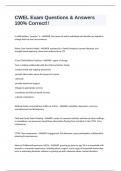CWEL Exam Questions & Answers
100% Correct!!
In child welfare, "practice" is - ANSWER the means by which individuals and families are helped to
change their bxs and circumstances
Illinois Core Practice Model - ANSWER anchored in a Family Centered, trauma informed, and
strength based approach, often times referred to as FTS
9 Core Child Welfare Practices - ANSWER -agent of change
-form a helping relationship with the child and his/her family
-conduct initial and ongoing assessment
-provide information about the impact of trauma
-advocate
-provide behavioral support
-linkage to appropriate services
-coordinate all child and family services
-cultural competence
Without family connectedness child is at risk for - ANSWER instability, depression, and even
unemployment and delinquency
Child and Family Team Meeting - ANSWER center of casework activities and how all other staffings,
or mandatory case processes should have information flowing from and back to the CFTM. 5 key
components.
CFTM 5 key components - ANSWER Engagement, full disclosure, open participation, collaboration,
planning for permanency.
Adverse Childhood Experiences (ACEs) - ANSWER growing up (prior to age 18) in a household with
stressful or traumatic experiences, including abuse, neglect, and a range of household dysfunction,
such as witnessing domestic violence or growing up with substance abuse, mental disorders,
, parental discord, or crime in the home, removal or displacement, three or more placements in an 18
month period.
Response to trauma throughout development: young children (2.5-6 years) - ANSWER helplessness
and passivity, generalized fear, confusion, difficulty identifying what is bothering them, attributing
magical qualities to traumatic reminders, fighting or threatening bx, attention problems,
sadness/depression, separation anxiety, specific fears, low frustration tolerance, hyperactive, moody,
aggressive defiant, lying, learning disabilities, social problems, suppressed immune system
Response to trauma throughout development: school age children (6-11 years) - ANSWER physical
complaints, bedwetting, school failure/absenteeism, behavioral problems, attention problems,
fighting or threatening bx, guilt feelings, acting like a parent to siblings, depression, defiant, lying,
stealing, learning disabilities, inappropriate emotional responses, self-blame, hypersensitivity to
physical contact, difficulties coordinating and balancing
Response to trauma throughout development: adolescents (12-18 years) - ANSWER antisocial bx,
eating disorders, runaway, dating violence, depression, suicidal, substance abuse, sleeping disorders,
school failure, absenteeism, relationship problems, acting like a parent to siblings, loses time,
difficulty seeing a future for oneself
3 kinds of stress - ANSWER positive stress, tolerable stress, toxic stress
postive stress - ANSWER moderate, short lived stress responses
tolerable stress - ANSWER More intense stress responses that allow enough time to recover, or
occur in a relatively safe environment with the presence of supportive adults
toxic stress - ANSWER Strong, frequent or prolonged activation of the body's stress management
system, without access to supportive adults
6 protective factors - ANSWER Existing strengths of the family.
Parental resilience
(strong and flexible)
social connections (parents need friends)
knowledge of parenting and child development
concrete supports in times or need




